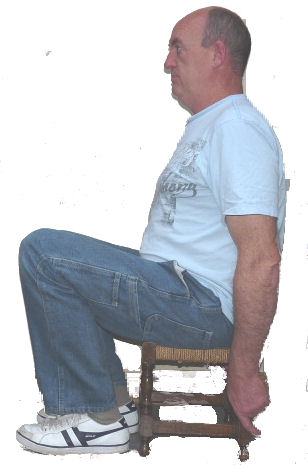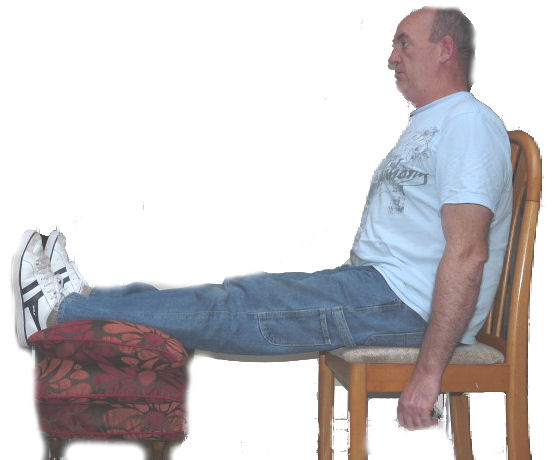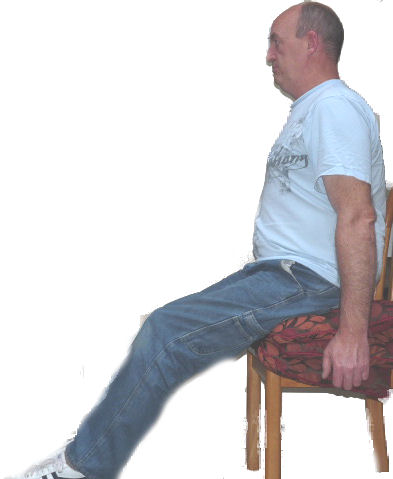Sitting correctly is essential for maintaining our circulation along with Inclined Bed Therapy (IBT)
The image shows the seat is slightly higher than the back of a persons knees affording legs to slope gently down. This posture enables gravity to assist your circulation by pulling denser blood, lymph and other fluids down towards the ground, which in turn generates a return flow back up the body. A simple flow and return system that assists the heart to drive the blood around our body has given us the ability to be ahad of the animal Kingom. When we stood up we did so because it felt good, it felt right and it changed our circulation completely.
Watch any new born animal in the wild or captivity and you can see it intially struggling to stand up. Yes it needs to do this because of predation but a new born has no knowledge of predaters so it stands up because it feel correct to do so. Initially the animal is wobbling around trying to stand erect and within a few minutes the hydroulics kick in and the animal is walking and in somae cases can run alongside it's mother. One could argue that human babies are more dependent on us because they spend many months being unable to walk, but you might be surprised to learn that babies in Africa have walked at age 5 months and there are cases in the UK such as this one. Yet in the workplace sitting at a desk our posture is not great, sitting in a car for example we are forced into wheelchair posture, which leads to people falling asleep at the wheel while driving.
Get our sitting posture wrong and we place not only our lives and health in danger. I have conducted experiments to confirm that simply raising ones seat in a car so that your sitting posture resembles the first image in this set of three and you can eliminate tiredness, get out of the car after a very long journey without feeling adverse affects including stiff legs and ballance issues. Soi something is not quie right with the car seat designs. However, many commercial vehicles afford the driver to sit fairly close to the image shown and I have driven trucks over long distances and noticed not feeling anywhere near as tired as when driving a car.

Incorrect sitting posture exagerated to show how modern seating in cars, wheelchairs, offices, and many other situations is adversely affecting our efficiency and health. We are frequently advised to put our legs and feet up to rest our legs after a long day, especially expectent mothers who are worried about getting varicose veins or feeling the effects of carrying their baby.

But is this advice wise? Is it based on anything other than assumptions? Does having your legs raised as illustrated assist or compromise your circulation?
Does it prevent or cure varicose veins? Of course not, yet doctors and nurses for no other reason than habitual assumptions that gravity is a froce we are struggling against instead of a force that we are harnessing and indeed a force that drives our cirulation keep making the same mistakes and expecting to get different results?
According To Joan Vernikos Sitting Incorrectly or for too long Kills us. We should take notice of Joan as she is the former head of Life Sciences at NASA
Our circulation does not stop at our bottom, it travels from head to toe and ideally should be uninterrupted by pressure and bends in the vessels, which is precisely what sitting accomplishes. Hospitals have raised the upper half of beds for certain conditions, but this unfortunately limits the patients ability to rotate in bed, and rotation is very important for assisting circulation, easing pressure points that lead to bed sores and ulceration and the movement of food through our digestive system. We were never designed to sit as we do for hours. Poor sitting posture is even worse, as this compromises the beneficial affects of gravity and in doing so slows down our circulation, causing lethargy and even inducing drivers to fall asleep at the wheel.
EFFECT OF DIFFERENT SITTING POSTURES IN WHEELCHAIR ON LUNG CAPACITY, EXPIRATORY FLOW IN PATIENTS OF SPINAL CORD INJURY (SCI)
Published: NATIONAL JOURNAL OF MEDICAL RESEARCH Volume 2 Issue 2 Apr – June 2012
SPINE INSTITUTE OF AHMEDABAD Prajapati Namrata P1, Bhise Anjali R2 1Physiotherapist, Vadodara 2Principal & Head, Government Physiotherapy College, Civil Hospital Campus, Ahmedabad http://njmr.in/uploads/2-2_165-168.pdf?fbclid=IwAR3ZuyaZWZj1Qw_i22v7HJCBaEh0BuuKcMxdgaMJj1Seg7y8IGPCVSeKqCQ
"DISCUSSION We evaluated the biomechanical effects on the LC-EF of different sitting postures on the LC-EF. Results show that posture significantly influenced spirometric parameters in tested subjects. The flow-volume loop is widely used in clinical practice to assess lung function for the condition of airways and the strength of the respiratory muscles.
The PEF reflects and measures the rate of flow from the large airways; it is also affected by the strength of the thoracic and abdominal muscles and the degree of muscular effort generated by the subject.20 The FVC is the total volume of air exhaled with maximal effort. FEF25%–75% is the flow rates at the corresponding percentage point of the FVC exhaled, and indicate the function of small or distal airways.19
The results of lumbar lordosis in this study are, in general, consistent with other published studies.22-26. In parallel with Subjects’ improved respiratory performance in the WO-BPS sitting posture over performances in the normal sitting posture. Although there is no evidence in the literature that changes in lumbar lordosis and kyphosis have significant influence on lung function, we think that these significant differences in lumbar lordosis in different postures may account for the changes in pulmonary capacity between the postures we tested.
A shape change in any one of these curvatures will cause compensatory changes in the others to help maintain balance and conserve muscular energy.27 adjustments to spinal alignment may change the volume of air available to the lung and/or influence the efficacy of contraction of the diaphragm and other respiratory muscles. Therefore, an increase in spinal lordosis in the lumbar region is likely to induce a decrease in thoracic kyphosis, thus giving the ribcage greater room to expand during inspiration.21 in this study, lumbar curve more in WO-BPS with lumbar curve than the normal sitting posture.
CONCLUSION by this study, we can say that WO-BPS with lumbar curve is better option for patients of SCI, sitting for prolong period of time because in this position improve the lung function in SCI patients than normal sitting posture. The WO-BPS with lumbar support sitting posture show significant improvement in FVC, PEFR, FEV1 and increasing values of FEF25-75% but it is not statistically significant. The following are recommendation for future study:
1. Including upper thoracic level of SCI patients and cervical level also.
2. To evaluate postural change effect on lung function particular in WO-BPS with lumbar curve, over a longer period of time by full wheelchair users with SCI patients.

